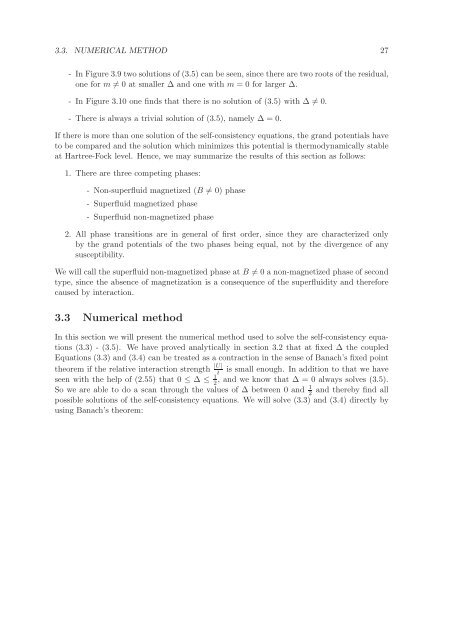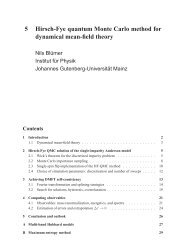Hubbard Model for Asymmetric Ultracold Fermionic ... - KOMET 337
Hubbard Model for Asymmetric Ultracold Fermionic ... - KOMET 337
Hubbard Model for Asymmetric Ultracold Fermionic ... - KOMET 337
You also want an ePaper? Increase the reach of your titles
YUMPU automatically turns print PDFs into web optimized ePapers that Google loves.
3.3. NUMERICAL METHOD 27- In Figure 3.9 two solutions of (3.5) can be seen, since there are two roots of the residual,one <strong>for</strong> m ≠ 0 at smaller ∆ and one with m = 0 <strong>for</strong> larger ∆.- In Figure 3.10 one finds that there is no solution of (3.5) with ∆ ≠ 0.- There is always a trivial solution of (3.5), namely ∆ = 0.If there is more than one solution of the self-consistency equations, the grand potentials haveto be compared and the solution which minimizes this potential is thermodynamically stableat Hartree-Fock level. Hence, we may summarize the results of this section as follows:1. There are three competing phases:- Non-superfluid magnetized (B ≠ 0) phase- Superfluid magnetized phase- Superfluid non-magnetized phase2. All phase transitions are in general of first order, since they are characterized onlyby the grand potentials of the two phases being equal, not by the divergence of anysusceptibility.We will call the superfluid non-magnetized phase at B ≠ 0 a non-magnetized phase of secondtype, since the absence of magnetization is a consequence of the superfluidity and there<strong>for</strong>ecaused by interaction.3.3 Numerical methodIn this section we will present the numerical method used to solve the self-consistency equations(3.3) - (3.5). We have proved analytically in section 3.2 that at fixed ∆ the coupledEquations (3.3) and (3.4) can be treated as a contraction in the sense of Banach’s fixed pointtheorem if the relative interaction strength |U|tis small enough. In addition to that we haveseen with the help of (2.55) that 0 ≤ ∆ ≤ 1 2, and we know that ∆ = 0 always solves (3.5).So we are able to do a scan through the values of ∆ between 0 and 1 2and thereby find allpossible solutions of the self-consistency equations. We will solve (3.3) and (3.4) directly byusing Banach’s theorem:













